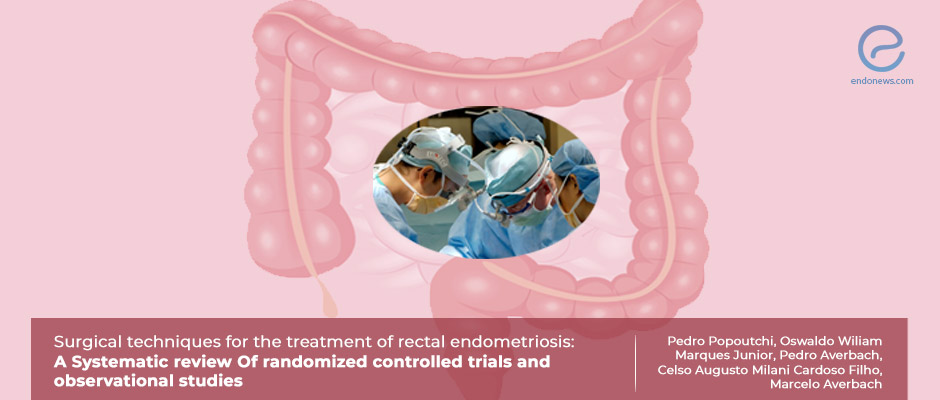Which surgical technique is best for rectal endometriosis?
Mar 18, 2022
The study compares three different surgical techniques in the treatment of rectal endometriosis
Key Points
Highlight
- Surgical intervention has given better results in terms of reducing the symptoms and lowering recurrence rates in patients with rectal endometriosis.
- The surgical technique should be decided by a multidisciplinary team weighing all the different characteristics of the disease and taking into account what the patient wants.
Importance
- The rectum is one of the most commonly affected sites in intestinal endometriosis cases, and the symptoms can alter a patient's quality of life.
What's done here
- This review study evaluates the randomized controlled and observational studies in terms of the surgical techniques used in the treatment of rectal endometriosis.
- The indications, techniques, outcomes, and complications were compared between three different techniques.
Key results
- Superficial resection (shaving) was found to be more simple with a shorter operation time, lower complication rates, and shorter hospitalization times.
- Compared to segmental and discoid resection, superficial resection shows higher recurrence rates.
- Discoid resection has promising results in lesions smaller than 3 cm.
- Segmental resection is related to significant relief in gastrointestinal and urinary symptoms.
- Segmental resection is indicated for lesions bigger than 3 cm and multifocal/extensive lesions.
- Segmental resection is associated with higher complete resection and lower recurrence rates.
Lay Summary
One of the common sites for deep endometriosis is the intestines, with a rate of 3-37%. Intestinal endometriosis constitutes a serious cause of gastrointestinal symptoms, pain, and the alteration of the quality of life, with the rectum and sigmoid colon being affected in the majority of the cases. Although clinical treatment may be beneficial in terms of reducing the lesion sizes and providing some symptom relief, the recurrence rate is high. Surgical intervention is deemed necessary in symptomatic patients.
The best surgical technique for rectal endometriosis has been an area of discussion. The approach should be decided individually for each patient with a thorough pre-surgical clinical and radiological examination by a multi-disciplinary team. Dr. Popoutchi et al. From Sao Paolo, Brazil, conducted a review study to evaluate the indications, techniques, and outcomes of different methods in the surgical treatment of rectal endometriosis. The study was published in a recent issue of the journal Arquivos de Gastroenterologia.
The randomized controlled and observational studies comparing different surgical techniques in rectal endometriosis were searched from the database. The outcomes were compared regarding mortality, recurrence, and complications. After the exclusion, one randomized controlled trial and nine observational studies, including 3327 patients, were assessed.
The resection techniques are grouped into two categories; the conservative approach aims to resect only the endometrial nodule and can be either discoid or superficial, whereas the radical approach includes segmental resections. In patients with superficial infiltration, a laparoscopic superficial resection or shaving is indicated. In comparison to segmental resection, it was found to be more simple, had a shorter operation time, lower complication rates, and shorter hospitalization times. However, it showed higher recurrence rates when compared to segmental and discoid resection. Discoid resection is performed in unifocal and deep lesions and requires a full-thickness resection. It showed promising results in lesions that were smaller than 3 cm. For more extensive and bigger lesions, segmental resection is performed. Significant improvement in gastrointestinal and urinary symptoms was reported after this procedure. Segmental resection is also associated with higher complete resection and lower recurrence rates.
The authors also discuss the complications for each surgical method and conclude by saying that the selection of the surgical approach should be individualized depending on the patient’s symptoms, the characteristics of the lesions, and the patient’s will.
Research Source: https://pubmed.ncbi.nlm.nih.gov/34909864/
endometriosis rectal endometriosis endometriosis surgery intestinal endometriosis

